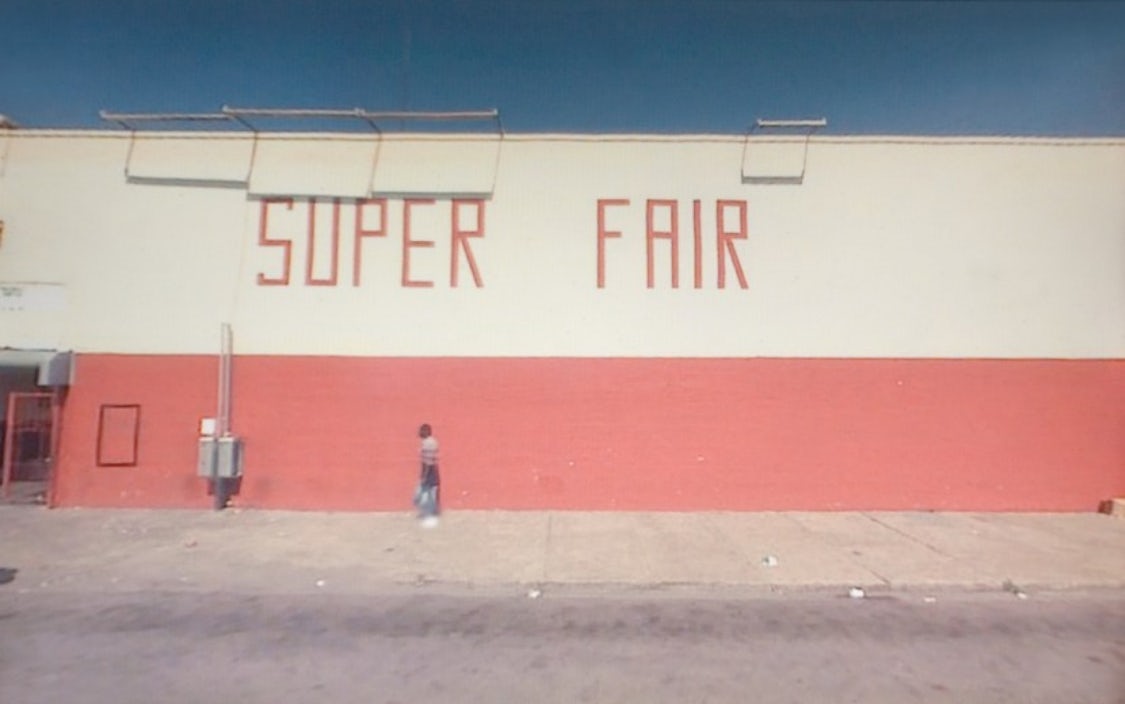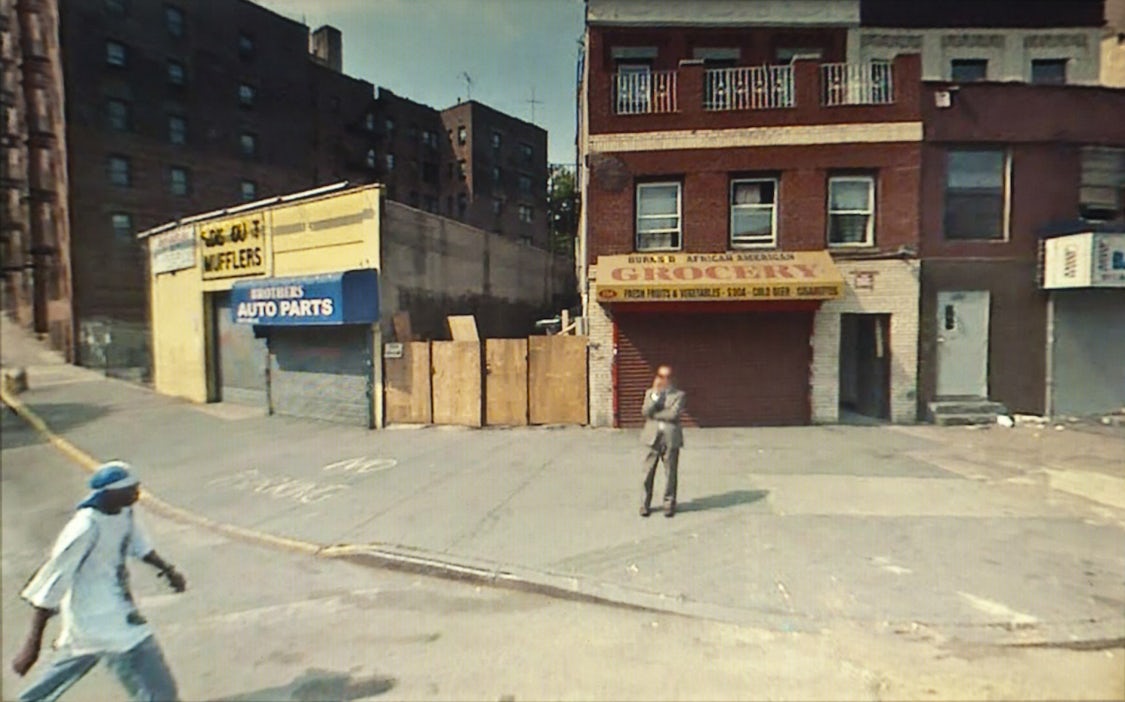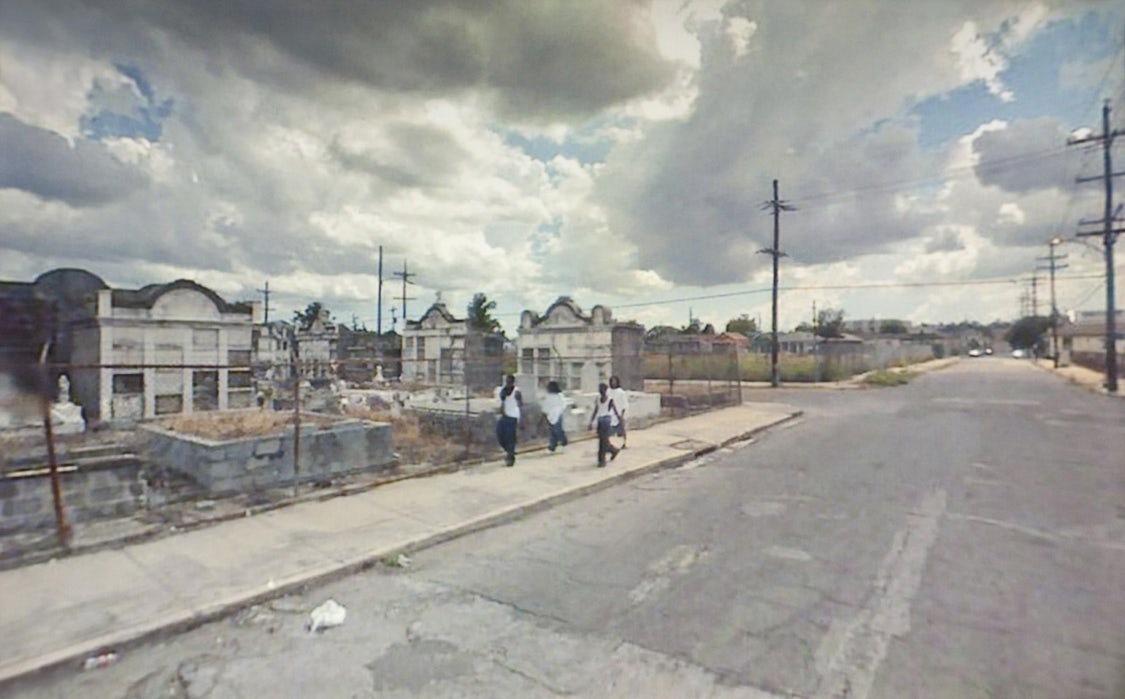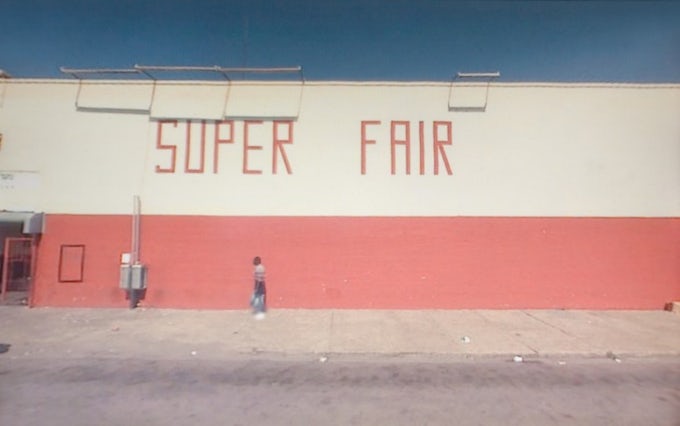






Doug Rickard is an American photographer whose practice appropriates catalogued imagery of American suburbs found in Google Street View, in order to compose a multi-layered scene which he then photographs to create a final, singular image. The resulting series, A New American Picture (2006–10), is a virtual road trip through desolate suburbs marred by racial inequality, poverty and the demise of domestic industry: a broken vision of Americana. Informed extensively by his background in sociology and United States history, Rickard’s project is a document of contemporary American life, but one that Walker Evans might have called ‘lyrical’ or ‘near’ documentary in its layering of different media and its manipulation of factual records.
Voyeurism, exploitation and personal privacy are at the fore of Rickard’s work – heightened by the knowledge that the entire series was made from the confines of the artist’s Sacramento home, where he re-photographed the internet images. In this interview Siobhán Bohnacker and Doug Rickard discuss issues of appropriation and authorship, potential artistic uses of widely accessible online tools, the ethical implications of street photography and the artist’s attempt at reflecting on America’s complex social history in this project.
SIOBHÁN BOHNACKER: You have appropriated Google Street View to, in essence, find and create the images for you; yet in photographing those screen shots, it becomes your work. Your process brings up the question of what a photograph is, and what role the photographer plays in the process of image-making.
DOUG RICKARD: When I started this project, I knew it would be polarising as it dealt with grandiose American themes, like tradition, technology, socio-economics and race. Because of practical issues – such as being a father, working in the technology sector and not having the freedom to travel around and take pictures – I wanted to find an alternative way to raise my voice and comment on America in a broad sense. So I started experimenting with search engines, found images, YouTube, etc.
When I came upon Google Street View in 2009 and started using it to explore places like Detroit, I was fascinated by the purpose of the tool itself. I couldn’t believe that these machines had gone out there, taking pictures in an automated fashion on such a scale, so that someone like myself could go to any little way out place, like areas in the South that Stephen Shore and Walker Evans had photographed, and make them accessible for me purely through the internet. In the way that these pictures had been made by machines, I perceived a certain sort of menace, a natural disrespect – the height of the camera, the blurred out faces, the imperfections, all of these things heightened the atmosphere. I was looking for a broken America, the inverse of the American dream.
SB: It’s certainly refreshing to hear an artist admit to the practicalities that limit one’s ability to make art in an idealistic fashion.
DR: Yes, sometimes constraints and practicalities can help someone to look for another way and give them the determination to try something brash and new. You can still find unlimited means of expression within practical limitations. It is possible to do that.
From a visual standpoint, I wanted the work to have a firm connection to Evans, Paul Graham and even Jacob Holdt and his series American Pictures. I am fascinated by their sense of tradition.
I started to find that the cameras used by Google vary in resolution geographically. For example, in downtown New York City they use high-definition cameras that heighten the realism but, for my purposes, lose the magic. The first generation cameras are so low in resolution that they are not just pixelated, but almost offer a watercolour texture. For the first few weeks I started working out my technical approach. I set up the tripod in my studio and knew I wanted to use a digital camera, and that ultimately I wanted the work to be printed, to give it physicality. I didn’t envisage it on monitors as part of an installation, I rather wanted to bring it out of the internet and connect it back with tradition. At first I started making the prints to find out if the images would hold up in terms of quality; I then started working methodically to find a narrative and to assert my position in relation to the pictures.
SB: Had you travelled to these specific locations – neighbourhoods in New Orleans, Michigan – I wonder whether you would have returned with a similar view.
DR: If I had travelled to these places, I would have wanted to build up a relationship or rapport with the people you see in the frame. I wouldn’t have been able to work anonymously; I would have felt the need to get an informal set of permissions in order to take their pictures. But the beautiful thing is that Google’s cars didn’t do that. People are staring back with suspicion, precisely because no one had asked their permission, almost like the mourners in Paul Fusco’s series of photographs, RFK Train (1968), who had no idea their picture was being taken. So it gave me a unique outcome that I couldn’t have attained in person – it would be an entirely different project.
SB: Throughout these images there is a deep sense of voyeurism, an invasion of privacy that capitalises on the subject’s ignorance of the presence of the camera. Did this become a determining factor in realising certain ‘scenes’?
DR: The pictures are actually taken from about eight feet in the air, so there is that added symbolism of power and control, which doesn’t exist in the same physical manner between people. When looking through a Google camera, you are a spectator, even more so than when looking through any other device. There is a detachment and a sense of alienation, which to me somehow makes the images feel apocalyptic. Something to be noted is the amount of movement within Google Street View. They take nine pictures and stitch them together. I probably took 10,000 images, which through extremely disciplined editing were ultimately consolidated into pictures that were coherent in colour and composition. I ended up with probably less than a hundred images. Through this sifting process, I would come upon a scene with potential, where I could recognise a certain promise; maybe the colour of the sky or the shade of a liquor store.
As these are 360-degree, stitched together, panoramic images, I actually make a lot of decisions regarding composition and framing. For instance, I can control the camera angle – pan it up and down, move along the street – in order to frame the person as I want to. So the resulting images are a strange hybrid of appropriation and authorial control.
SB: This ambiguous area between appropriation and ‘true’ documentary is prevalent in your work. You are only able to control a second-hand truth, which has already been presented by Google. Do you feel your work sits within documentary or would you rather consider this fictional element to be at the fore of your practice?
DR: In my series A New American Picture, the world is frozen and I’m navigating through it. This was a viscerally satisfying process for me – I experienced the same joy finding a suitable picture for the project than I would editing pictures taken in ‘real time’ on the street. I worked for three or four hours each night during months because the individual pictures had to be incredibly strong for what I wanted to do. I didn’t want this project only to be about Google, but about street photography and tradition, ultimately I wanted to ask what makes an interesting photograph. If I remove all the watermarks, for instance, it’s because I would like this project to instigate a conversation on race, socio-economics and what it means to live in America, rather than on Google.
SB: It can’t have escaped you that you appear socially detached from the largely black neighbourhoods you portray. How do you react to those arguing that your project reinforces racial and social stereotypes and prejudices?
DR: There are a few ways to answer that. This exploitative aspect is inherent to photography’s nature and its history, and to street photography in particular. I don’t think there is ever a way to avoid it completely. From the moment you are taking a picture of someone on the street and then showing it to other people, no matter if you are portraying poor or affluent people, anything you do within photography is open to a dialogue surrounding the exploitation of someone else’s identity.
Evans used to say that his photographs weren’t political and yet there were times when he also said that his photography was in direct opposition to the values his parents held. In my case, I feel that there are large groups of people who have been ignored by the media. This project looks at the neighbourhoods where African Americans are living on the heels of decades of Jim Crow laws and slavery.01 I am documenting my own interest in these conditions and in thinking about how an invisible part of our country has been left devastated by self-serving governing bodies.
SB: As a photographer you heavily rely on the internet to source your content, yet you wouldn’t describe your practice as new media. Your references rather lie in the traditional medium of painting and the pioneers of photography.
DR: Yes. For instance, in one of the images of A New American Picture, which shows a man riding a bike in New Jersey, past a white door, the building appears perfectly flat. The colour in this image resembles that of Edward Hopper’s oil painting Sunday (1926). But more generally, the colour that is woven into the series is also similar to the palette that I love in William Eggleston’s or Shore’s work. I studied United States history, mainly slavery and the African American civil rights movement (c. 1955–1968), and all of those things that, from a broader standpoint outside of photography, constituted the America that I was interested in. It all sort of ties together. Whether in colour, tradition or subject matter, it feels very American.
SB: Americana, the great American expanse, the notion of the American Dream – why this obsession with your homeland?
DR: In our house, heroes were men like Ronald Reagan. The values taught, and the way in which America was held to me was very patriotic and embodied the ideals of a particular 1950s America. When I eventually went to college to study history, I was left with a conflicted view of America, one seen in two very different lights. I developed an obsession and passion to understand the ideals and the contradictions of this country. My father was a preacher, as was my grandfather, two of my uncles and my brother-in-law. Yet when studying the civil rights period at school, I couldn’t believe what people of colour were being subjected to. I couldn’t make sense of the fact that these people who saw themselves as so godly could also be treating minorities in that way. That background informs my work. Conflict of ideologies is woven into the work that I make.
Footnotes
-
The Jim Crow laws refer to the laws that enforced racial segregation in public spaces of the South of the United States from the 1870s to the late 1950s, when they were finally declared unconstitutional thanks to protests carried out by civil rights movements across the country.
